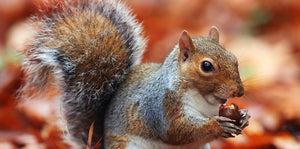At PAWS, as well as helping you care for your domestic pet, we also want to help you look after the wildlife you might find in your back garden.
In Britain, we are extremely lucky to have so much wildlife around us and there are a number of ways we can help the animals that come into our gardens in their hunt for food. The type of garden you have will determine the type of wildlife it will attract. A garden with few plants, trees and grass will attract less wildlife than one with lots of hedges and flowering plants which provide food and shelter. Ponds will attract insects and amphibians, while compost heaps can be a great shelter for hedgehogs.

There are two types of squirrel that are native to great Britain. These animals do not hibernate during the winter months, instead they collect food during the year which they hoard in preparation for winter.
Grey Squirrel
 Originally Native to North America, grey squirrels were first introduced to the UK in the 19th century. The species has spread rapidly and is now common across the UK, with the exception of some areas in Scotland. The grey squirrel is very active, bounding from tree to tree and scurrying around on the ground looking for food.
Originally Native to North America, grey squirrels were first introduced to the UK in the 19th century. The species has spread rapidly and is now common across the UK, with the exception of some areas in Scotland. The grey squirrel is very active, bounding from tree to tree and scurrying around on the ground looking for food.
Red Squirrel
 The red squirrel is very rare, so you are far more likely to see the grey squirrel in your garden. They only survive on the Isle of Wight and Brownsea Island, where there are no greys, on the Formby coast, and in the extensive pine forests of Northumberland and the Lake District. Sadly the grey squirrel carry a disease which kills the red squirrel.
The red squirrel is very rare, so you are far more likely to see the grey squirrel in your garden. They only survive on the Isle of Wight and Brownsea Island, where there are no greys, on the Formby coast, and in the extensive pine forests of Northumberland and the Lake District. Sadly the grey squirrel carry a disease which kills the red squirrel.
Diet
- fungi
- bulbs
- roots
- acorns

How to attract squirrels into your garden
Squirrels like peanuts, hazelnuts and sunflower seeds. We stock peanuts in their shell which are popular food for squirrels.

